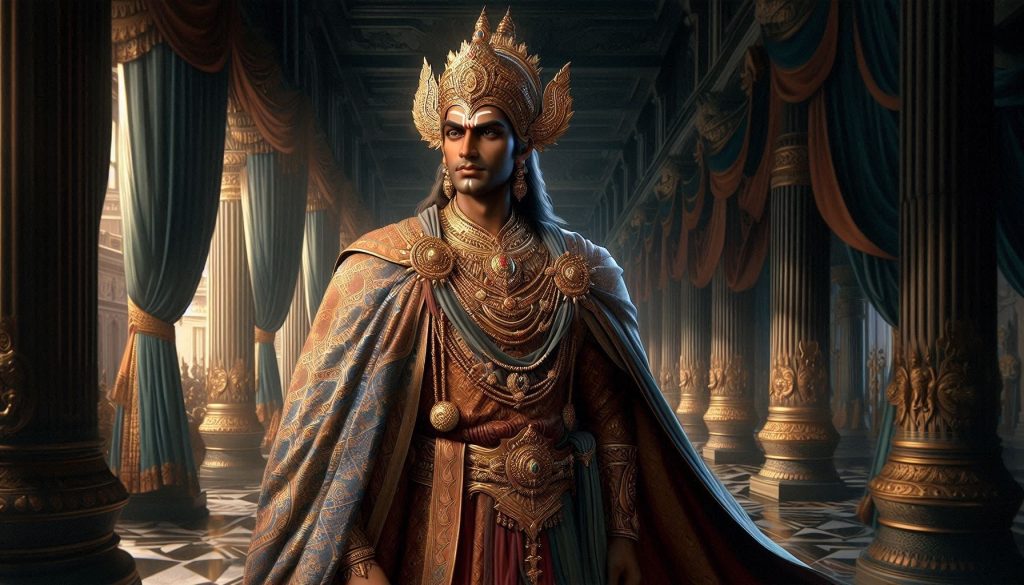This Guru Dakshina story follows a young Brahmin boy named Kautsa, whose dedication to his teacher leads him on a journey to fulfill an extraordinary promise. With the help of the generous King Raghu and divine intervention, Kautsa gathers a fortune as Guru Dakshina, symbolizing respect, wisdom, and the power of generosity. This tale weaves the values of Dussehra (Vijayadashami)—honor, humility, and the triumph of virtue—into a timeless tradition still celebrated today.
In the heart of Ayodhya, known for its temples and rivers, lived a young Brahmin named Kautsa. He was a devoted student of the sage Rishi Varatantu, who was wise in the 14 shastras, or sciences, that covered everything from ethics and astronomy to linguistics and mathematics. For years, Kautsa absorbed each lesson with respect and dedication, eventually mastering all that his teacher had to offer.
When his studies were complete, Kautsa approached his teacher with a humble yet resolute wish to offer Guru Dakshina, a traditional gift of thanks. Despite Rishi Varatantu’s protest that a teacher’s duty was reward enough, Kautsa insisted. Moved by his devotion, the sage finally relented but decided on a symbolic gesture. He requested 140 million (14 Crore) gold coins—one million coins for each of the 14 sciences he had imparted.
Kautsa, who owned little beyond his robes and prayer beads, was taken aback but undeterred. He promised his guru he would fulfill this request and set off to find a way. Knowing that Ayodhya’s King Raghu was famous for his generosity, he made his way to the palace.
King Raghu’s Promise

King Raghu, known for giving without hesitation, listened with great interest as Kautsa explained his mission. Moved by the young man’s determination, the king felt a deep sense of duty to help.
“Kautsa,” the king said kindly, “you honor your teacher with such devotion. I will do everything in my power to grant you these coins, though such a sum is vast. Give me three days, and I will procure them for you.”
Grateful for the king’s help, Kautsa agreed and waited patiently. Raghu, however, quickly realized that even his treasury did not hold 140 million gold coins. Determined to fulfill his promise, he prayed to Lord Indra, the king of the gods, hoping for a miracle.
Divine Intervention
Lord Indra, recognizing the purity of Raghu’s intentions, summoned Kuber, the god of wealth, to assist. Together, they devised a plan. The following dawn, as the people of Ayodhya stirred awake, they were astonished to find that the branches of the Apta and Shanu trees around the palace sparkled with golden coins. Kuber had rained down gold, adorning the trees as if they bore golden fruit.
King Raghu was overjoyed. He gathered 140 million coins from the trees and summoned Kautsa to the palace.
“Kautsa,” he said, gesturing to the bounty before them, “the gods themselves have blessed your endeavor. Here is the Guru Dakshina you sought.”
Completing the Guru Dakshina
Kautsa, awestruck, gathered the coins and returned to Rishi Varatantu. The sage accepted exactly 140 million coins, no more, no less, then instructed Kautsa to return the rest to King Raghu.
Upon returning to Ayodhya, Kautsa offered the surplus back to the king, but Raghu shook his head with a gentle smile. “Distribute the wealth among our people, Kautsa,” he said. “Let everyone share in this blessing.”
On that day, which coincided with Vijayadashami, Kautsa distributed the remaining gold among the people of Ayodhya. This event marked a day of shared prosperity and generosity, embodying the spirit of Vijayadashami as a celebration of victory, respect, and abundance.
Significance of Kautsa’s Story for Dussehra
Kautsa’s story adds a unique layer of meaning to Vijayadashami, often celebrated as the victory of good over evil, as seen in Lord Rama’s triumph over Ravana. Yet, this tale speaks of a quieter triumph: the victory of devotion, respect, and communal sharing. In memory of Kautsa’s quest, people in some regions of India exchange Aapta leaves on Dussehra, symbolizing prosperity and goodwill.
The leaves, exchanged in place of gold, serve as a reminder that true wealth lies in values like respect for teachers, gratitude, and the joy of giving. This tradition reminds people that victory isn’t only about external conquests; it’s about conquering selfishness, embracing generosity, and honoring shared blessings.
Through Kautsa’s tale, Dussehra becomes more than a festival of light over darkness—it becomes a celebration of duty, kindness, and the prosperity that flows from virtuous actions.